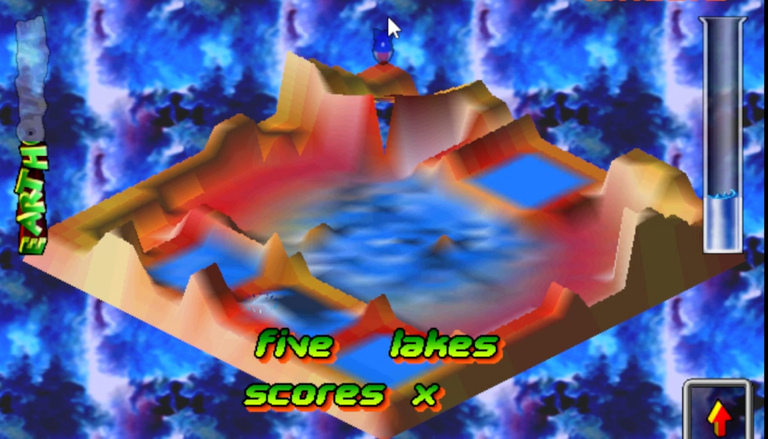

Wetrix is a rather curious game that I've known about for a few years now - I don't remember from where, but I definitely remember having quite a bit of interest in it being another puzzle game with a unique premise to keep me entertained for quite a while. And now I finally come to tell you about it since I tried it again after years having forgotten about its existence.
All the pictures I am going to show you are from the Windows version, and at the end I will explain the curious thing about it.
The premise is similar to Tetris very superficially: pieces will fall that you can rotate to fit whatever you want...
...But here the pieces are not blocks as such, but shapes that will lift or flatten the ground they fall on.
For example, if you get a piece in the shape of a square with arrows pointing up, when it falls, it will raise a small square/well where it lands...regardless of whether the terrain is flat or not.
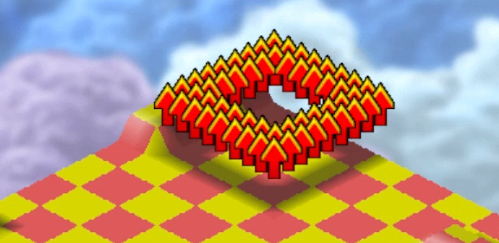

On the other hand, the green arrows going down will flatten the terrain where they land.
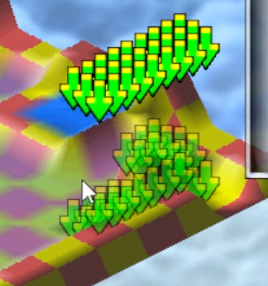
The goal of these terrain pieces is to create small wells and large lakes with the water pieces that will soon start falling...and if this water manages to escape over the edges of the map, it will raise a water meter that will end your game if it fills up.
That's the basics: Create terrain so that the falling water doesn't overflow. And something that helps to keep the amount of water in control, as well as give points, are the fireballs that will completely dry the lake they fall into. They award more points by drying a lake large enough to have a Rainbow Multiplier, but they also add more points if you have several lakes that add to the overall multiplier.

But there are a few more things that will act as obstacles:
- The amount of terrain increases the Earthquake meter, which is why you want to flatten all terrain that is useless. If it fills up, all the terrain is going to crumble...and assuming you already have full lakes, it will be inevitable that all that water will overflow and end your game.
- Eventually you will have to deal with pieces of pumps which, when they fall, leave a hole in the ground through which water can seep in. The strategy is to make these fall in a dry spot to prevent that from happening...but if more than one falls in a row, be sure to make them fall near but not exactly over a hole...or more will appear and destroy your game.
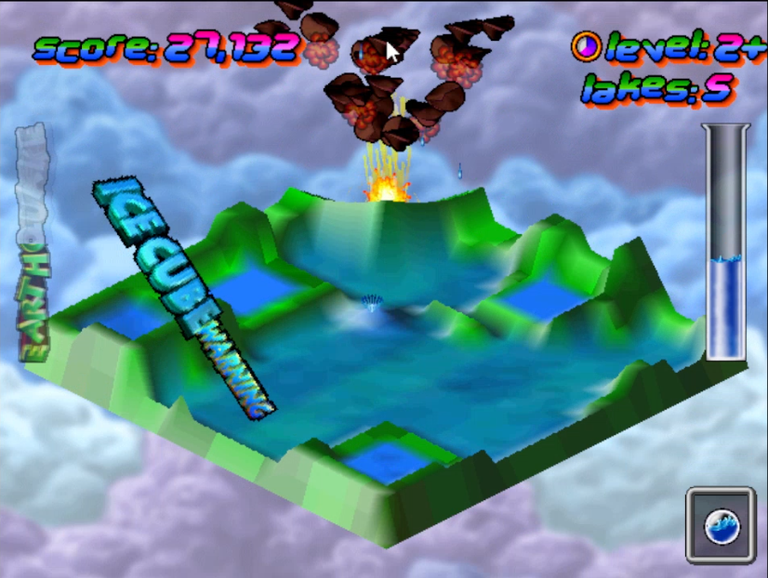
- Ice cubes can decide to appear on their own above any of the lakes you have. The only way to keep them from freezing your lake [even if it eventually restores itself] is to place terrain right where it is going to fall so that it touches dry ground...or have the fireball to dry out the lake just before it falls. Having the ice fall on dry land gives you quite a few extra points, so it's more convenient to do that than to let it freeze a lake.
- The last thing you will see in obstacles will be mines, which will also fall on their own in particular lakes...and if you try to use a fireball on a lake with mines, they will explode leaving holes in the ground. These also disappear over time, but may be a reason why you might want to make at least two or three lakes so that there is a chance they will fall into a small lake and not lose the bonus of drying up your large lake.
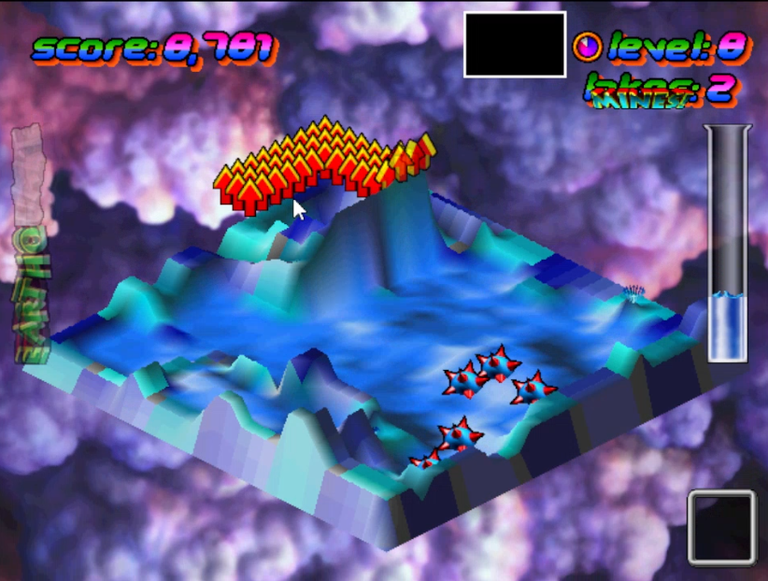
...And I'm aware that these are a lot of things to describe that, without context and just pictures...it's hard to understand. But they are things that you could see and grasp with this explanation if you get to see some games of this game, or better, they would help to understand and learn how to play this, as it becomes engaging to achieve a constant state of survival when you have to manage multiple lakes, avoid ice and mines, and even set aside a space just for pieces of junk terrain to flatten them with pieces, bombs or even fireballs to avoid earthquakes.
Well, leaving aside the explanation of the game itself, you have a classic infinite until you perish mode, a Pro mode where you start with higher speed and more advanced pieces, a Challenge mode that lets you choose between certain challenges to survive [Default pieces, 100/500 pieces, 1/5 minute game. ...the 1 minute mode in particular can be brutal with the speed and efficiency needed to get a high score], a Handicap mode where you put an extra condition on your game [Ice well in the center, half full water meter on each level, random gaps, random terrain].
It's not AMAZING in variety of modes, but for how particular this game is, at least it's nice that it has more than just a single basic mode. And it even has a versus mode in all versions...for that day when you somehow get someone who wants to play this with you.
I want to point out that the version I show you on screen with screenshots has a unique look compared to the Nintendo 64 and Dreamcast versions which, besides being more likely to have been seen before, are in full 3D with a camera that moves and on top of that is adjustable in how close it is, compared to this version in the pictures which is a fixed isometric screen.
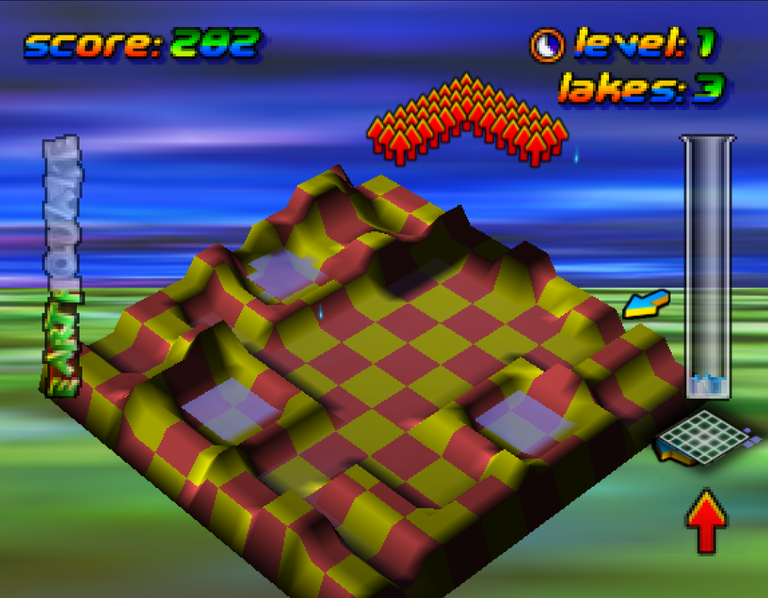
I find it curious since it's obvious that it's like this to fit the limitations of most computers at that time in the 90's, but it doesn't take away from the intrigue that it looks different than the console versions. The PC version even though it looks like this, it still has that eye-candy in the water physics and how you can see the polygons of the terrain rise up instead of being something like blocks stacking up.
I could compare it to the Game Boy Color version which is also fixed isometric...obviously this one is much more limited by the console and looks like stacking blocks, but it's still impressive that they even tried to translate that premise to a handheld like that.
Anyway, a curious game for a curious anecdote: I wouldn't say it's a game that can constantly hook me nowadays like, say, Tetrisphere or Tetris The Grandmaster...but I can't deny that if it lets me start a good game, it's going to be hard to see it finished until 10 minutes or more in which I end up making some mistake that ends it.
Thank you very much for reading.

English translation with DeepL. All screenshots were captured by myself.
Español
Wetrix es un juego bastante curioso que conozco desde hace unos cuantos años- no recuerdo de donde, pero definitivamente recuerdo tenerle bastante interés al ser otro juego de puzzles con una premisa única para tenerme entretenido por un buen rato. Y ahora finalmente vengo a contarles de esto ya que volví a probarlo después de años habiendo olvidado de su existencia.
Todas las fotos que voy a mostrar son de la versión de Windows, y al final le explicaré lo curioso de esto.
La premisa es similar a Tetris muy superficialmente: Van a caer piezas que puedes girar para que se ajusten a lo que quieras...
...Pero aquí las piezas no son bloques como tal, sino formas que levantaran o aplanarán el terreno en el que caigan.
Por ejemplo, si recibes una pieza en forma de un cuadrado con flechas apuntando hacia arriba, al caer, levantará un pequeño cuadrado/pozo en donde caiga...independientemente de si el terreno es plano o no.


Por otra parte, las flechas verdes que van hacia abajo aplanarán el terreno donde caigan.

El objetivo de estas piezas de terreno es crear pequeños pozos y grandes lagos con las piezas de agua que pronto empezarán a caer...y si esta agua se logra escapar por los bordes del mapa, subirá un medidor de agua que terminará tu partida si se llena.
Eso es lo básico: Crear terreno para que el agua que caiga no se desborde. Y algo que ayuda para mantener en control la cantidad de agua, así como dar puntos, son las bolas de fuego que secarán completamente el lago en el que caigan. Otorgan más puntos secando un lago lo suficientemente grande para tener un Multiplicador Arcoiris, pero también se le suman más puntos si tienes varios lagos que añaden al multiplicador general.

Pero hay unas cosas más que van a hacer de obstáculos:
- La cantidad de terreno aumenta el medidor de Terremoto, el cual es el motivo por el cual quieres aplanar todo terreno que sea inútil. Si se llena, todo el terreno se va a desmoronar...y asumiendo que ya tienes lagos llenos, será inevitable que toda esa agua se desborde y termine tu partida.
- Eventualmente tendrás que lidiar con piezas de bombas que al caer, dejan un hueco en el piso por el cual se puede filtrar el agua. La estrategia es hacer que estos caigan en un lugar seco para evitar que eso pase...pero si caen más de uno seguidos, asegúrate de hacer que caigan cerca pero no exactamente encima de un hueco...o aparecerán más y te destruirán la partida.

- Los cubos de hielo pueden decidir aparecer por su cuenta por encima de cualquiera de los lagos que tengas. La única forma de evitar que congelen tu lago [aunque este eventualmente se restaure solo] es colocar terreno justo en donde vaya a caer para que toque tierra seca...o tener la bola de fuego para secar el lago justo antes de que caiga. Hacer que el hielo caiga en tierra seca te da bastante puntos extra, así que conviene más hacer eso que dejar que te congele un lago.
- Lo último que verás en obstáculos serán minas, que también caerán por si solas en lagos particulares...y si intentas usar una bola de fuego en un lago con minas, explotarán dejando huecos en el terreno. Estas también desaparecen con el tiempo, pero pueden ser un motivo por el cual convendría hacer al menos dos o tres lagos para que haya una oportunidad de que caigan en un lago pequeño y no perder el bonus de secar tu lago grande.

...Y estoy consciente de que estas son muchas cosas que describir que, sin contexto y solo con imágenes...es difícil de entender. Pero son cosas que podrías ver y captar con esta explicación si llegas a ver algunas partidas de este juego, o mejor, ayudarían a entender y aprender a jugar esto, ya que llega a ser enganchante el lograr un estado constante de sobrevivencia cuando tienes que manejar múltiples lagos, evitar el hielo y las minas, y hasta apartar un espacio solo para piezas de terreno basura para aplanarlos con piezas, bombas o hasta bolas de fuego para evitar terremotos.
Bueno, dejando de lado la explicación del juego en sí, tienes un modo clásico infinito hasta que perezcas, un modo Pro en el que empiezas con una velocidad mayor y piezas más avanzadas, un modo Challenge que te deja escoger entre ciertos retos para sobrevivir [Piezas predeterminadas, 100/500 piezas, partida de 1/5 minutos...el modo de 1 minuto en particular puede ser brutal con la velocidad y eficiencia necesaria para sacar un alto puntaje], un modo Handicap en el que te pones una condición extra en tu partida [Pozo de hielo en el centro, medidor de agua medio lleno en cada nivel, huecos aleatorios, terreno aleatorio].
No es INCREÍBLE en variedad de modos, pero para lo particular que es este juego, al menos es agradable que tenga más que un solo modo básico. Y hasta tiene un modo versus en todas las versiones...para aquel día en el que de alguna forma consigas alguien que quiera jugar esto contigo.
Quiero destacar que la versión que les muestro en pantalla con capturas tiene una apariencia única comparado con las versiones de Nintendo 64 y Dreamcast que, además de ser más probables que hayas visto antes, están en completo 3D con una cámara que se mueve y encima es ajustable en que tan acercado está, comparado con esta versión en las fotos que es una pantalla fija isométrica.

Me parece curioso ya que es obvio que es así para poder encajar con las limitaciones de la mayoría de computadoras en aquella época de los 90, pero no quita la intriga de que se vea de una forma distinta que las versiones de consola. La versión de PC aunque se ve así, sigue teniendo esa vistosidad en las físicas de agua y como se pueden ver los polígonos del terreno levantarse en vez de ser algo como bloques apilándose.
Podría compararlo con la versión de Game Boy Color que también es isométrico fijo...obviamente este se ve mucho más limitado por la consola y se ve como apilar bloques, pero sigue siendo impresionante que siquiera intentaran en trasladar esa premisa en una portátil como esa.
En fin, un juego curioso para una anécdota curiosa: No diría que sea un juego que pueda engancharme constantemente hoy en día como, digamos, Tetrisphere o Tetris The Grandmaster...pero no puedo negar que si me deja empezando una buena partida, va a ser difícil verla concluída hasta 10 minutos o más en el que termine cometiendo algún error que le de fin.
Muchas gracias por leer.

Traducción al inglés hecha con DeepL. Todas las fotos capturadas por mí.
Congratulations @acstriker! You have completed the following achievement on the Hive blockchain And have been rewarded with New badge(s)
Your next target is to reach 2000 comments.
You can view your badges on your board and compare yourself to others in the Ranking
If you no longer want to receive notifications, reply to this comment with the word
STOPThis looks like a minion game